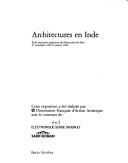| Listing 1 - 3 of 3 |
Sort by
|

ISBN: 2866530284 9782866530280 Year: 1985 Publisher: Paris : Electa Moniteur,
Abstract | Keywords | Export | Availability | Bookmark
 Loading...
Loading...Choose an application
- Reference Manager
- EndNote
- RefWorks (Direct export to RefWorks)
Vernacular architecture --- Architecture --- Architecture vernaculaire --- Exhibitions. --- History --- Expositions --- Histoire --- Architecture contemporaine --- Architecte --- Le Corbusier, Charles-Edouard Jeanneret, --- 20e siècle --- Inde --- Vernacular architecture - India - Exhibitions --- Architecture - India - History - 20th century - Exhibitions --- Le Corbusier, Charles-Edouard Jeanneret, 1887-1965
Book
ISBN: 9783775732451 3775732454 9788192043203 8192043207 Year: 2011 Publisher: Ostfildern : Hatje Cantz,
Abstract | Keywords | Export | Availability | Bookmark
 Loading...
Loading...Choose an application
- Reference Manager
- EndNote
- RefWorks (Direct export to RefWorks)
Architecture --- History --- Histoire --- Histoire de l'architecture --- Inde --- 72.036 --- 72.037 --- India --- 72.032.1 --- 72.032.14 --- 72.039(540) --- 72.038(540) --- Architectuur ; Indië ; 1990-2010 --- Architectuur ; Indië ; 20ste en 21ste eeuw --- 20ste eeuw (architectuur) --- Twintigste eeuw (architectuur) --- 21ste eeuw (architectuur) --- Eenentwintigste eeuw (architectuur) --- Oosterse en aziatische architectuur --- Indiase architectuur --- Architectuurgeschiedenis ; 2000 - 2050 ; Indië --- Architectuurgeschiedenis ; 1950 - 2000 ; Indië --- Architecture - India - History - 20th century --- Architecture - India - History - 21st century
Book
ISBN: 9782353400997 235340099X Year: 2010 Publisher: Montreuil Gourcuff Gradenigo
Abstract | Keywords | Export | Availability | Bookmark
 Loading...
Loading...Choose an application
- Reference Manager
- EndNote
- RefWorks (Direct export to RefWorks)
Cet ouvrage de référence a été conçu par deux passionnés de design et d'architecture : Éric Touchaleaume et Gérald Moreau, qui ont séjourné plusieurs fois par an en Inde depuis 1999. Il illustre et inventorie ainsi les réalisations architecturales indiennes des deux créateurs et pour la première fois le mobilier conçu pour la ville nouvelle de Chandigarh. En 1951, le Premier Ministre Jawaharlal Nehru choisit Le Corbusier pour la réalisation de la nouvelle capitale du Penjab : Chandigarh, symbole d'une Inde libre et moderne. Le Corbusier dessine le plan directeur de la ville et les bâtiments du Capitole : l'Assemblée, le Secrétariat et la Haute Cour, il propose à son cousin Pierre Jeanneret de superviser les chantiers sur place. Il réalise également le Palais des Filateurs, deux luxueuses villas et un musée, pour de riches commanditaires d'Ahmedabad, capitale de l'état du Gujarat. Pierre Jeanneret accomplit, en outre, un travail indépendant du "maître" et réside en Inde de 1951 à 1965. En plus de son activité d'architecte, Pierre Jeanneret met au point une gamme de meubles très épurés, en teck, cannages ou revêtement de coton, secondé par de jeunes assistants indiens, au sein d'un programme intitulé "Low Cost Furniture" destiné à équiper les différents bâtiments privés et publics de Chandigarh. Il puise son inspiration dans l'artisanat local traditionnel, et dans ses créations antérieures réalisées en France, seul, ou aux côtés de Le Corbusier, de Charlotte Perriand, ou de Jean Prouvé qui rendra hommage à son ami : "(...) Avec les moyens les plus simples, il proposait timidement des merveilles qu'il s'agisse d'architecture ou de meubles (...)" (Jean Prouvé) Edition bilingue français-anglais. http://213.244.11.247/BTP/Livre/9782353400997 (3/12/10)
Architecture --- Art --- Design --- Mobilier d'architecte --- City planning --- Bâtiment culturel --- Bâtiment public --- Bâtiment universitaire --- Histoire de l'architecture --- Histoire de l'urbanisme --- Histoire des villes --- Histoire du mobilier --- History --- Jeanneret, Pierre --- Le Corbusier, Charles-Edouard Jeanneret, --- Le Corbusier, --- Jeanneret, Pierre, --- Ahmedabad --- Chandigarh --- Inde --- Chandīgarh (India) --- France --- Buildings, structures, etc --- 72.07 --- Architectuur ; Indië ; 20ste eeuw ; Le Corbusier en Pierre Jeanneret --- Meubelkunst ; 20ste eeuw ; Le Corbusier --- Le Corbusier (Charles-Edouard Jeanneret) 1887-1965 (°La Chaud-de-Fonds, Neuchâtel, Zwitserland) --- Architectuur ; Modernisme ; functionalisme --- Jeanneret, Charles-Edouard --- Jeanneret, Pierre 1896-1967 (°Genève, Zwitserland), neef van Le Corbusier. --- Creation (Literary, artistic, etc.) --- Cities and towns --- Civic planning --- Land use, Urban --- Model cities --- Redevelopment, Urban --- Slum clearance --- Town planning --- Urban design --- Urban development --- Urban planning --- Land use --- Planning --- Art, Municipal --- Civic improvement --- Regional planning --- Urban policy --- Urban renewal --- Architecture, Western (Western countries) --- Building design --- Buildings --- Construction --- Western architecture (Western countries) --- Building --- Architecten. Stedenbouwkundigen A - Z --- Government policy --- Management --- Design and construction --- Jeanneret-Gris, Arnold André Pierre, --- Gris, Arnold André Pierre Jeanneret-, --- Jeanneret, Arnold André Pierre, --- Jeanneret-Gris, Charles Edouard, --- Gris, Charles Edouard Jeanneret-, --- Jeanneret, Charles Edouard, --- Corbusier, Edouard le, --- Le Corbusier, Eduard, --- Le Corbusier-Saugnier, --- Corbusier, --- Kebiyi, --- Korubyujie, --- Le Korbi︠u︡zʹe, --- Le Kebuxiye, --- Lu Kūrbūziyah, --- Ru Korubyujie, --- Rangnalei, Chaersi Aidehua, --- 勒・柯布西耶, --- 让纳雷, 查尔斯・爱德华, --- Chandigarh (India) --- Buildings, structures, etc. --- Chandīgarh (India) --- Jeanneret, Pierre 1896-1967 (°Genève, Zwitserland), neef van Le Corbusier --- Chandīgarh --- Caṇḍīgaṛha (India) --- Le Corbusier (pseudoniem van Charles-Edouard Jeanneret 1887-1965 (°La Chaux-de-Fonds, Neuchâtel, Zwitserland) --- Ле Корбюзьє, --- Architecture, Primitive --- Architecture - India - History - 20th century - Pictorial works --- City planning - India - Chandīgarh - History - 20th century - Pictorial works --- Design - India - History - 20th century - Pictorial works --- Jeanneret, Pierre, 1896-1967 --- Le Corbusier, Charles-Edouard Jeanneret, 1887-1965 --- Le Corbusier, - 1887-1965 --- Jeanneret, Pierre, - 1896-1967 --- Chandīgarh (India) - Buildings, structures, etc - Pictorial works
| Listing 1 - 3 of 3 |
Sort by
|

 Search
Search Feedback
Feedback About UniCat
About UniCat  Help
Help News
News